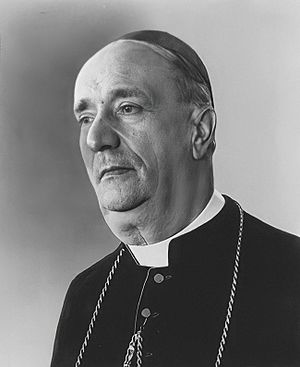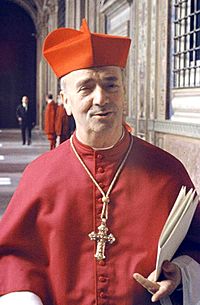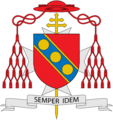Alfredo Ottaviani facts for kids
Quick facts for kids His Eminence Alfredo Ottaviani |
|
|---|---|
| Pro-Prefect of the Congregation for the Doctrine of the Faith | |

Ottaviani in 1966
|
|
| Appointed | 9 February 1966 |
| Reign ended | 8 January 1968 |
| Predecessor | Giuseppe Pizzardo |
| Successor | Franjo Šeper |
| Other posts | Cardinal-Priest of Santa Maria in Domnica |
| Orders | |
| Ordination | 18 March 1916 |
| Consecration | 19 April 1962 by Pope John XXIII |
| Created Cardinal | 12 January 1953 |
| Rank |
|
| Personal details | |
| Born | 29 October 1890 Rome, Kingdom of Italy |
| Died | 3 August 1979 (aged 88) Rome, Italy |
| Buried | San Salvatore in Ossibus Church, Vatican City |
| Nationality | Italian |
| Denomination | Roman Catholic |
| Parents |
|
| Previous post |
|
| Motto |
|
| Signature | |
| Coat of arms |  |
Alfredo Ottaviani (born October 29, 1890 – died August 3, 1979) was an Italian cardinal in the Catholic Church. Pope Pius XII made him a cardinal in 1953. He worked as the secretary of the Holy Office, an important department in the Roman Curia (the Vatican's government), from 1959 to 1966. When this department was reorganized and renamed the Congregation for the Doctrine of the Faith, he became its pro-prefect until 1968.
Cardinal Ottaviani was a very important person in the Catholic Church during his time. He was known as the main conservative voice at the Second Vatican Council, a major meeting that changed many things in the Church.
Contents
Early Life and Studies
Alfredo Ottaviani was born in Rome, Italy. His father worked as a baker. Alfredo went to school with the Brothers of the Christian Schools in Trastevere, a part of Rome. He then studied at the Pontifical Roman Seminary and the Pontifical Roman Athenaeum S. Apollinare. From these schools, he earned advanced degrees in philosophy, theology, and Church law. He became a priest on March 18, 1916.
Leading the Holy Office
On January 12, 1953, Pope Pius XII made him a Cardinal-Deacon and also appointed him as a leader of the Holy Office. This office was responsible for protecting Catholic teachings. As a cardinal, he took part in the 1958 meeting where cardinals elected Pope John XXIII as the new Pope.
On November 7, 1959, he became the main guardian of the Vatican's teachings as the secretary of the Holy Office. In 1962, he was made an Archbishop, and Pope John XXIII himself consecrated him (made him a bishop). His motto, Semper idem, means "Always the same." This motto showed his strong belief in keeping traditional Catholic teachings. He later gave up his title as Archbishop in 1963.
Second Vatican Council
The Second Vatican Council (1962-1965) was a very important meeting for the Catholic Church. Cardinal Ottaviani played a big role, often speaking for more traditional views.
He did not agree with the idea of a complete separation of Church and State. He also believed that while all religions should be tolerated, public displays of non-Catholic religions should be limited if possible. During the Council, he had strong disagreements with other cardinals. For example, he debated changes to the Mass (the main Catholic worship service) and how the Church understands divine revelation (God's communication to humanity, through the scripture and tradition).
Journalists often asked Cardinal Ottaviani for his opinions during the Council. Once, when people kept talking about "collegiality" (bishops working together), he joked that the Bible only showed the apostles working together once: when they all ran away in the Garden of Gethsemane.
Cardinal Ottaviani often disagreed with German Cardinal Josef Frings. Frings was a more liberal leader who wanted faster changes in the Church. Frings had a young theological advisor named Joseph Ratzinger, who later became Pope Benedict XVI. Ratzinger helped Frings prepare speeches that outlined a new direction for the Council.
One famous event happened on November 8, 1963. Cardinal Frings publicly called Ottaviani's department a "source of scandal" to the world. This showed how strong the disagreements were.
Another well-known incident happened on October 30, 1962. During a discussion about changing the Mass, Cardinal Ottaviani spoke for too long, going over the 10-minute limit. He argued against changes, saying the Mass should not be treated "as if it were a piece of cloth to be refashioned according to the whim of each generation." When he kept speaking, the cardinal leading the session, Cardinal Bernard Alfrink, rang a warning bell. When Ottaviani still didn't stop, his microphone was turned off. Ottaviani, who had poor eyesight, stumbled back to his seat. Some people in the hall applauded, showing they thought he had spoken too long.
This incident upset Ottaviani, and he did not attend the next six Council meetings. Later, another cardinal asked people not to applaud or disapprove during speeches. News reporters noted that non-Catholic observers at the Council were impressed by how much freedom of speech there was.
Papal Conclave of 1963
Cardinal Ottaviani was one of the cardinals who voted in the 1963 papal conclave. This meeting elected Giovanni Battista Montini as the new Pope. Ottaviani was the protodeacon, meaning he was the senior cardinal-deacon. Because of this, he was the one who announced Montini's election to the world. He also placed the tiara (a special crown) on Pope Paul VI's head during his coronation on June 30.
Later Work and Retirement
In 1965, the Holy Office was renamed the Congregation for the Doctrine of the Faith. Ottaviani was then named its pro-prefect. The Pope himself held the title of "prefect." In 1967, Ottaviani was raised to the rank of cardinal-priest. As pro-prefect, Ottaviani saw himself as a "policeman" protecting traditional Church teachings.
On January 8, 1968, Cardinal Ottaviani retired from his position in the Church's central government. Pope Paul VI accepted his resignation. He was replaced by Cardinal Franjo Seper from Yugoslavia. This change was seen as a big moment, showing the Church moving away from very strict traditionalism towards new ideas and different relationships with countries like those under Communist rule.
In 1970, Pope Paul VI decided that cardinals over 80 years old could no longer vote in papal elections. Cardinal Ottaviani, who was already 80, said this decision went against centuries of Church tradition. He felt the Pope was getting rid of many wise and experienced advisors.
Cardinal Ottaviani passed away on August 3, 1979.
Important Impacts
Karl Rahner
In 1962, Cardinal Ottaviani put a rule on a theologian named Karl Rahner. This meant Rahner could not publish or give lectures without special permission. However, a few months later, Pope John XXIII appointed Rahner as an expert advisor for the Second Vatican Council. So, even though Ottaviani had restricted him, Rahner was still able to help at the Council.
Ottaviani Intervention
On September 25, 1969, Cardinal Ottaviani and Cardinal Antonio Bacci wrote a letter to Pope Paul VI. This letter supported a study by a group of theologians who had concerns about the new way the Mass was being celebrated and the new rules for it. This letter became widely known as the Ottaviani Intervention.
Church Procedures and Secrecy
In 1962, Cardinal Ottaviani, as head of the Holy Office, signed a document called Crimen sollicitationis. This document outlined how the Church should handle certain serious crimes. It explained that judges and other officials involved in these cases had to keep everything secret. If they revealed details, they would face serious Church penalties. However, victims and witnesses were not under the same strict secrecy rules. In fact, anyone who knew about such a crime and did not report it within a month could also face Church penalties. The document also stated that punishments for the accused, like being suspended from celebrating Mass, were public.
Forbidden Books
As the secretary of the Holy Office, Cardinal Ottaviani was responsible for banning certain books. These books would have been added to the Index Librorum Prohibitorum (Index of Prohibited Books), a list of books Catholics were not allowed to read. The Index was officially ended by Pope Paul VI in 1966.
Faustina Kowalska
On March 6, 1959, the Holy Office issued a statement that stopped the spread of "images and writings that promote devotion to Divine Mercy in the forms proposed by Sister Faustina." Faustina Kowalska was a Polish nun who wrote in her diary about her conversations with Jesus Christ. The ban was partly because of concerns that some of her claims about forgiveness of sins were too strong and seemed to go against what the sacraments offered. However, with Ottaviani's approval, Archbishop Karol Wojtyła (who later became Pope John Paul II) began studying Faustina's life in 1965. The ban on her work was lifted by Pope Paul VI in 1978.
Maria Valtorta
Cardinal Ottaviani also had concerns about the writings of Maria Valtorta, who said she had visions of Jesus and Mary. Her notebooks were published in 1956 as The Poem of the Man-God. In 1960, Pope John XXIII signed a decree banning all the books on a list presented by Ottaviani, which included Valtorta's work.
Images for kids
See also
 In Spanish: Alfredo Ottaviani para niños
In Spanish: Alfredo Ottaviani para niños





